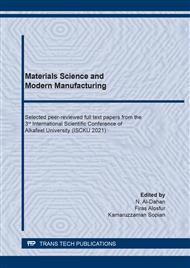[1]
P.B. Adhi, A. Purwidyantri, and K. Liu. Surface Plasmon resonance optical sensor: A review on light source technology., Biosensors 8.3 (2018): 80.
DOI: 10.3390/bios8030080
Google Scholar
[2]
P. S. Menon, et al. Kretschmann based surface Plasmon resonance for sensing in visible region., 2019 IEEE 9th International Nano electronics Conferences (INEC). IEEE, (2019).
DOI: 10.1109/inec.2019.8853847
Google Scholar
[3]
M. Celina, F. M. Shimizu, and M. Ferreira. Surface Plasmon resonance (SPR) for sensors and biosensors., Nano characterization techniques. William Andrew Publishing, 2017. 183-200.
DOI: 10.1016/b978-0-323-49778-7.00006-0
Google Scholar
[4]
Z. Rozalina, et al. Sensitivity Comparison of Refractive Index Transducer Optical Fiber Based on Surface Plasmon Resonance Using Ag, Cu, and Bimetallic Ag–Cu Layer., Micro machines 11.1 (2020): 77.
DOI: 10.3390/mi11010077
Google Scholar
[5]
O. Meisam, et al. Protein based localized surface Plasmon resonance gas sensing., Chinese Physics Letters 32.1 (2015): 018701.
DOI: 10.1088/0256-307x/32/1/018701
Google Scholar
[6]
Duaa muthana, Alaa Nazar Abd Algaffar, Abdullah Ibrahim Abbo Al-Numan, Design and Evaluation of a Polarizer Filter, Baghdad Science Journal, 2018, (15), 287-291.
Google Scholar
[7]
P. K. Maharana, R. Jha and S. Palei. Sensitivity enhancement by air mediated graphene multilayer based surface Plasmon resonance biosensor for near Infrared,, Sensors and Actuators B, 190(2014) 494– 501.
DOI: 10.1016/j.snb.2013.08.089
Google Scholar
[8]
Y. Masahiro. Surface Plasmon resonance (SPR) theory: tutorial., Review of Polarography 48.3 (2002): 209-237.
Google Scholar
[9]
S.Zeng, B. Dominique, H. Ho-Pui,Y. Ken-Tye,Nanomaterials enhanced surface Plasmon resonance for biological and chemical sensing applications, . Chemical Society Reviews, 43 (2014) 3426–3452.
DOI: 10.1039/c3cs60479a
Google Scholar
[10]
T. Kentaro, et al. Surface Plasmon polariton resonance of gold, silver, and copper studied in the kretschmann geometry: Dependence on wavelength, angle of incidence, and film thickness., Journal of the Physical Society of Japan 86.12 (2017): 124721.
DOI: 10.7566/jpsj.86.124721
Google Scholar
[11]
B. E. A Saleh, M. C. Teich, Fundamentals of Photonics, Wiley-Interscience, (2007).
Google Scholar
[12]
M. W. Maisarah, S. Shaari, and P. S. Menon. Propagation of surface Plasmon waves at metal thin film/air interface using modified optical wave guiding assembly., Opt electron Adv. Mat 7 (2013): 9-13.
Google Scholar
[13]
B. E. A. Saleh, M. C. Teich, Fundamentals of Photonics, 2 (2007) 212-214.
Google Scholar
[14]
M. N. Faezah, W. M. Mukhtar, P. S. Menon, A. R. Abdul Rashid, K. A. Dasuki, and A. A. Yussuf. Influence of electromagnetic (EM) waves polarization modes on surface Plasmon resonance., In EPJ Web of Conferences, EDP Sciences, 162 (2017) 01008.
DOI: 10.1051/epjconf/201716201008
Google Scholar
[15]
N.Lukas, and B.Hecht. Principles of Nano-optics. Cambridge university press, (2012).
Google Scholar
[16]
P. Ayushi, et al. Room temperature detection of NO2 gas using optical sensor based on surface Plasmon resonance technique., Sensors and Actuators B: Chemical 216 (2015): 497-503.
DOI: 10.1016/j.snb.2015.03.095
Google Scholar
[17]
M.N. Faezah, et al. Influence of electromagnetic (EM) waves polarization modes on surface Plasmon resonance., EPJ Web of Conferences. Vol. 162. EDP Sciences, (2017).
DOI: 10.1051/epjconf/201716201008
Google Scholar
[18]
M.W. Maisarah, R.M. Halim, and H. Hassan. Optimization of SPR signals: Monitoring the physical structures and refractive indices of prisms., EPJ Web of Conferences. Vol. 162. EDP Sciences, (2017).
DOI: 10.1051/epjconf/201716201001
Google Scholar
[19]
M.W. Maisarah, et al. Study on Plasmon absorption of hybrid Au-GO-GNP films for SPR sensing application., AIP Conference Proceedings. Vol. 1972. No. 1. AIP Publishing LLC, (2018).
DOI: 10.1063/1.5041228
Google Scholar


